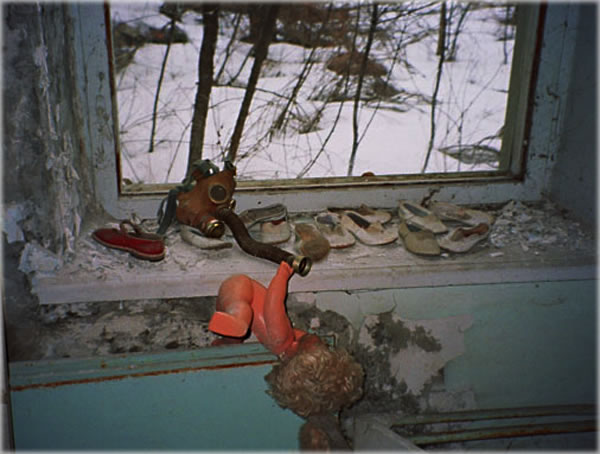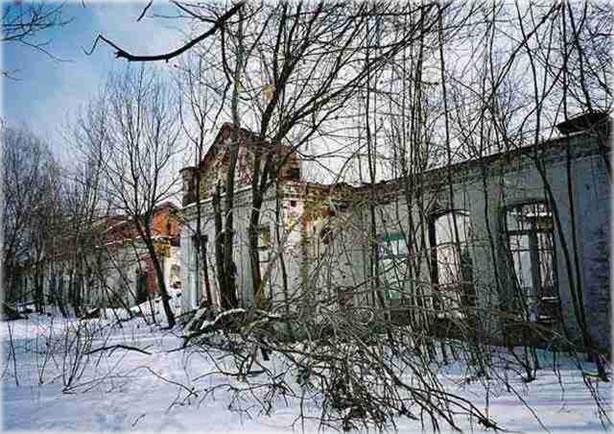 Photo by Elena Filatova
Photo by Elena Filatova
 By Eric Francis By Eric Francis
I CAN RELATE to Chernobyl because I have seen so much environmental damage in the United States. Chernobyl was and is far worse, but it never seemed like someplace else, or something we were exempt from elsewhere.
Among these disasters I am most familiar with is the Love Canal area of Niagara Falls, a neighborhood where 700 homes were contaminated with dioxin. There, on the site of the 99th Street School, is a grass-covered clay cap that buries the schoolyard, and the toxic waste dump directly beneath it, three-quarters of the way to the tops of utility poles. They poke up a few feet and follow the line of a long-forgotten street.
Seeing that for the first time one afternoon, I witnessed the tragedy of civilization. It was like finding the Statue of Liberty's torch sticking up out of the ground. No place is exempt. This is both frightening and reassuring; we're in this environmental game together.
Chernobyl happened in the Ukraine. When I was a kid, my best friend Eric Olynik's family was Ukrainian, so the place was always real to me; I had heard of it, and knew stories from there, and had a feeling for the people: proud, down-to-earth and bold. At the time the Ukraine was part of the USSR, but Ukrainians always made the point that it was its own country. Today, production on Planet Waves occurs in the Ukraine because that is the home of our webmaster, Anatoly Ryzhenko.
Before Chernobyl, I knew about nuclear power because my father worked in the industry as a public relations and communications consultant. He came in shortly after Three Mile Island and was part of the team that helped clean up the PR disaster that the partial meltdown in Harrisburg, PA, created.
I became suspicious then, but was listening carefully to both sides of the issue. Somewhere there is a photo of me in a radiation suit inside the containment building of what was then called Indian Point Nuclear Power Plant near Peekskill, NY, where with my dad I was given the VIP facility tour one day. Over my shoulder was a radiation warning sign. The previous person to get the big tour was Jimmy Carter, a week earlier. The place is controversial because it's located within one of the most concentrated population centers of the world. Nuclear engineers have a knack for a ridiculous lack of foresight, and for making some serious mistakes.
From what I knew about nuclear power, Chernobyl seemed like a setup. At the time, in the spring of 1986, it hit me in the stomach. Coming at a crucial point of reorienting my life, I knew at that moment it was my destiny to be involved with environmental issues. I just did not know what or when, but I was radicalized.
I was living in Buffalo at the time, and as the disaster spread, I was in bed for a week, unable to process much of reality. If I was not actually taking a significant enough dose of radiation to knock me down like that (we all took at least a small dose), I was taking it energetically, and I could barely communicate my feelings. The whole experience was psychic and emotional rather than cognitive. I was in the midst of my Chiron first square, and this was one of about five different factors, all of about equal force, that made the spring of 1986 a point of no return.
 Photo by Elena Filatova
Photo by Elena Filatova
We did not have television where I lived, in the Generation house at 54 Vernon Place. I was spared the visions that I can now see in these photos from the dead zone. Here, you will meet a young woman named Elena Filatova, who travels the area around Chernobyl taking photos of the ghost cities and towns, describing what she sees and experiences. She is eloquent, honest and funny. She uses all her senses. She is my sister, sending postcards back from these places without names.
"As long as we travel through the Wolves Land, we only see the shadows of a dead villages and ruined farms," Elena writes in one photo caption. "We also see, the grass that growing aside the road, we call this grass Chernobyl, the wormwood. It has bitter taste."
In one photo essay, she writes, "By territory Ukraine is a bit bigger than France, and in history books it was called a bread basket of Europe. It is because in Ukraine is 40% world's supply of black earth. Soil is good here, put a stick into this soil and it will grow. Now, this bread basket flavoured with wormwood and no one want to buy food products made in Ukraine."
In another caption she writes, "If we travel in autumn, the fruit trees will bent low asking to treat ourself to those big apples and pears, but we don't take them."
In one photo essay of destroyed property, she says: "The fire engines never returned in their garages, and the firemen never returned to their homes," she writes. "The firemen were the first on the scene, and they thought it was an ordinary fire. No one told them what they were really dealing with."
She conveys the feeling that Chernobyl happened on an ordinary spring day like today. One day you were going to work, your kids were going to school, and by that night, your life as you knew it no longer existed. You can think of Chernobyl as a radiation disaster, as a power plant burning, as brave pilots dumping sand and lead on a burning graphite fire. But you can also think of it as the delicate patterns of lives that were disrupted that day; the loss of all things familiar; the onset of change too vast and devastating to understand, but experienced personally simply as loss.

The Horoscope of Chernobyl
I DID NOT know that a dangerous system test immediately preceded the Chernobyl disaster -- that in effect, it was triggered by human action, even if unintended. According to Elena, the reactor's defenses had been lowered, and a series of human errors and mechanical failures led first to a steam explosion, then to a fire in the graphite cooling core of the reactor. This fire spread most of the radiation around the globe, though about two-thirds went to neighboring Belarus.
Uranus is rising to the degree, symbolic of something sudden. With Sagittarius in the ascendant, we have something sudden that shocks the world, and apropos of Uranus, spreads radiation throughout the world.
Saturn is also in Sagittarius, opposite Chiron in Gemini. I get the feeling from this that it could have been a lot worse; I guess it always can. We are currently experiencing a series of Saturn-Chiron oppositions right now, which seem to reveal the weakness within a structural system.
Notice that this is an eclipse chart. There was an eclipse of the Moon two days earlier, in early Scorpio. You can tell that an eclipse is in the neighborhood because the Sun is near one of the lunar nodes. When that occurs, you always know there is an eclipse or two in the vicinity. The Moon has just opposed the Sun, which was the Scorpio Full Moon; that was a pretty potent total eclipse. You will find this in many charts associated with world turning points.
The eclipse on April 24 and the system test coincided within 24 hours. This is one of those circumstances where I think it would be good for scientists to use astrology, but of course they exist on two entirely different levels of reality. For us as people who follow astrology, it's a good indication of why it's better to let eclipses get out of the way before doing something dangerous, such as surgery. In any event, Chernobyl is associated with a total eclipse of the Moon in Scorpio, which is fitting enough, given how many people died, how many will die and the fear (and toxins) that were spread around the world.
Notice that the Sun is exactly opposite Pluto. So we have a double signification of radiation: Uranus in the ascendant to the degree, and the Sun opposing Pluto to the degree. Neptune is taking an exact trine from the Sun; that is because Pluto and Neptune were moving at the same speed in a 60-degree angle, the famous "transiting yod" that affected many people's lives in those years because it meant simultaneous transits from both Neptune and Pluto -- that is a lot.
Notice also that a trine is involved -- Sun to Neptune. We see once again how trines open the flow of energy, and that it's not necessarily so helpful.
This chart is best seen in the context of the Nuclear Axis chart. Most of the world's atomic disasters occur when the important planets are in aspect to planets in the chart for the first self-sustaining nuclear reaction. That chart has many planets in early through mid Gemini and Sagittarius, including Uranus and Saturn (just like in the Chernobyl chart), as well as the Sun, Mercury and Venus.
The Moon in the Chernobyl chart (at 24+ degrees) is close to Mars of the Nuclear Axis chart (at 21+ degrees). And, notably, Neptune and the Moon in the Nuclear Axis chart are exactly opposite the Aries Point, in the first two degrees of Libra.
In recent years, we have been through many outer-planet transits to the Nuclear Axis chart, but without a serious nuclear emergency, at least not one that was made public. I consider this a miracle. We have, however, experienced a lot of nuclear politicking, threats and counter-threats, and North Korea detonating a device and China proving it could take out our space-based weapons if it wants to (praise the lord, we have a lot of them).
We did experience the Sept. 11 incident. Ominously, the scene was referred to as "ground zero," which is an ill-omened reference to the scene of a nuclear detonation. It may well be that what we experienced as Sept. 11 was a reduced form of the same karma that gave us essentially the same message. Abused as that message is, had a nuke gone off that day, it would have been a whole other game.
|
|